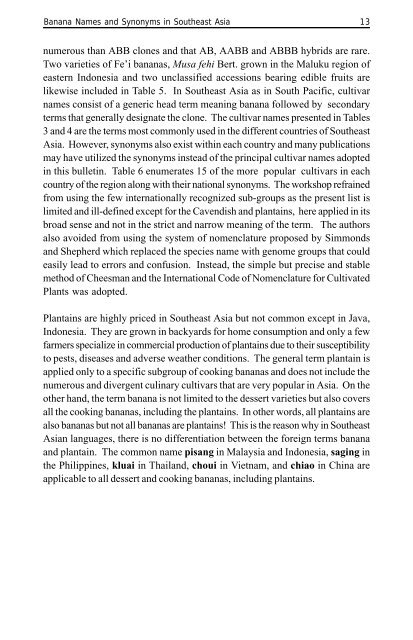Banana cultivar names and synonyms in Southeast Asia - Bioversity ...
Banana cultivar names and synonyms in Southeast Asia - Bioversity ...
Banana cultivar names and synonyms in Southeast Asia - Bioversity ...
Create successful ePaper yourself
Turn your PDF publications into a flip-book with our unique Google optimized e-Paper software.
<strong>Banana</strong> Names <strong>and</strong> Synonyms <strong>in</strong> <strong>Southeast</strong> <strong>Asia</strong> 13<br />
numerous than ABB clones <strong>and</strong> that AB, AABB <strong>and</strong> ABBB hybrids are rare.<br />
Two varieties of Fe’i bananas, Musa fehi Bert. grown <strong>in</strong> the Maluku region of<br />
eastern Indonesia <strong>and</strong> two unclassified accessions bear<strong>in</strong>g edible fruits are<br />
likewise <strong>in</strong>cluded <strong>in</strong> Table 5. In <strong>Southeast</strong> <strong>Asia</strong> as <strong>in</strong> South Pacific, <strong>cultivar</strong><br />
<strong>names</strong> consist of a generic head term mean<strong>in</strong>g banana followed by secondary<br />
terms that generally designate the clone. The <strong>cultivar</strong> <strong>names</strong> presented <strong>in</strong> Tables<br />
3 <strong>and</strong> 4 are the terms most commonly used <strong>in</strong> the different countries of <strong>Southeast</strong><br />
<strong>Asia</strong>. However, <strong>synonyms</strong> also exist with<strong>in</strong> each country <strong>and</strong> many publications<br />
may have utilized the <strong>synonyms</strong> <strong>in</strong>stead of the pr<strong>in</strong>cipal <strong>cultivar</strong> <strong>names</strong> adopted<br />
<strong>in</strong> this bullet<strong>in</strong>. Table 6 enumerates 15 of the more popular <strong>cultivar</strong>s <strong>in</strong> each<br />
country of the region along with their national <strong>synonyms</strong>. The workshop refra<strong>in</strong>ed<br />
from us<strong>in</strong>g the few <strong>in</strong>ternationally recognized sub-groups as the present list is<br />
limited <strong>and</strong> ill-def<strong>in</strong>ed except for the Cavendish <strong>and</strong> planta<strong>in</strong>s, here applied <strong>in</strong> its<br />
broad sense <strong>and</strong> not <strong>in</strong> the strict <strong>and</strong> narrow mean<strong>in</strong>g of the term. The authors<br />
also avoided from us<strong>in</strong>g the system of nomenclature proposed by Simmonds<br />
<strong>and</strong> Shepherd which replaced the species name with genome groups that could<br />
easily lead to errors <strong>and</strong> confusion. Instead, the simple but precise <strong>and</strong> stable<br />
method of Cheesman <strong>and</strong> the International Code of Nomenclature for Cultivated<br />
Plants was adopted.<br />
Planta<strong>in</strong>s are highly priced <strong>in</strong> <strong>Southeast</strong> <strong>Asia</strong> but not common except <strong>in</strong> Java,<br />
Indonesia. They are grown <strong>in</strong> backyards for home consumption <strong>and</strong> only a few<br />
farmers specialize <strong>in</strong> commercial production of planta<strong>in</strong>s due to their susceptibility<br />
to pests, diseases <strong>and</strong> adverse weather conditions. The general term planta<strong>in</strong> is<br />
applied only to a specific subgroup of cook<strong>in</strong>g bananas <strong>and</strong> does not <strong>in</strong>clude the<br />
numerous <strong>and</strong> divergent cul<strong>in</strong>ary <strong>cultivar</strong>s that are very popular <strong>in</strong> <strong>Asia</strong>. On the<br />
other h<strong>and</strong>, the term banana is not limited to the dessert varieties but also covers<br />
all the cook<strong>in</strong>g bananas, <strong>in</strong>clud<strong>in</strong>g the planta<strong>in</strong>s. In other words, all planta<strong>in</strong>s are<br />
also bananas but not all bananas are planta<strong>in</strong>s! This is the reason why <strong>in</strong> <strong>Southeast</strong><br />
<strong>Asia</strong>n languages, there is no differentiation between the foreign terms banana<br />
<strong>and</strong> planta<strong>in</strong>. The common name pisang <strong>in</strong> Malaysia <strong>and</strong> Indonesia, sag<strong>in</strong>g <strong>in</strong><br />
the Philipp<strong>in</strong>es, kluai <strong>in</strong> Thail<strong>and</strong>, choui <strong>in</strong> Vietnam, <strong>and</strong> chiao <strong>in</strong> Ch<strong>in</strong>a are<br />
applicable to all dessert <strong>and</strong> cook<strong>in</strong>g bananas, <strong>in</strong>clud<strong>in</strong>g planta<strong>in</strong>s.

















